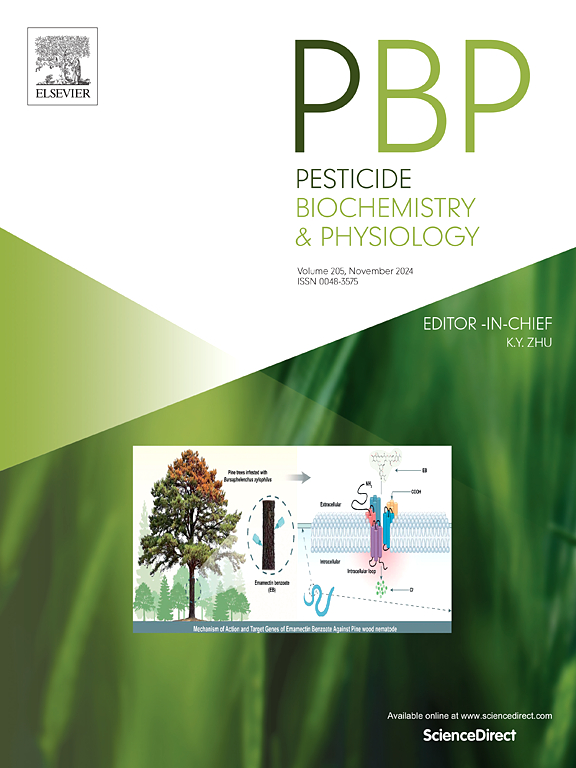Design and synthesis of sulfur-containing pseudilin analogs and their biological activity evaluation
IF 4.2
1区 农林科学
Q2 BIOCHEMISTRY & MOLECULAR BIOLOGY
引用次数: 0
Abstract
Pseudilin is a natural product that inhibits the enzyme 4-diphosphocytidyl-2C-methyl-D-erythritol synthase (IspD) in the methylerythritol phosphate (MEP) pathway, and using it as a template for designing lead structure is an effective strategy in developing new active compounds. In this work, a series of sulfur-containing pseudilin analogs were designed by replacing the pyrrole rings in pseudilin with pyrazole rings through bioisosteric replacement strategy, while introducing sulfur-containing groups. The target compounds were synthesized through a four-step reaction sequence, in which the key intermediate of sulfur-containing chromones was obtained by cyclization reaction, further transannulation, oxidation, and finally bromination. The bioactivity evaluation demonstrated that most of the synthesized compounds exhibited certain IspD enzyme inhibitory activity and good pre-emergence model plants inhibitory activity. Notably, these compounds showed stronger inhibitory effects on the monocot Echinochloa crus-galli (E. crus-galli) compared to the dicot Brassica napus L (B. napus L). In particular, compound 5h exhibited potent inhibitory activity against the Arabidopsis thaliana IspD (AtIspD) enzyme and achieved the highest pre-emergence herbicidal activity, superior to the control pentabromopseudilin (PBQ). The molecular docking results showed that compound 5h could bind well to the allosteric site of AtIspD, and the confirmed 5h and PBQ bind to the IspD in a similar way. These results suggest that the sulfur-containing compound 5h may represent a novel herbicide lead compound with new mode of action targeting IspD in the MEP pathway.

求助全文
约1分钟内获得全文
求助全文
来源期刊
CiteScore
7.00
自引率
8.50%
发文量
238
审稿时长
4.2 months
期刊介绍:
Pesticide Biochemistry and Physiology publishes original scientific articles pertaining to the mode of action of plant protection agents such as insecticides, fungicides, herbicides, and similar compounds, including nonlethal pest control agents, biosynthesis of pheromones, hormones, and plant resistance agents. Manuscripts may include a biochemical, physiological, or molecular study for an understanding of comparative toxicology or selective toxicity of both target and nontarget organisms. Particular interest will be given to studies on the molecular biology of pest control, toxicology, and pesticide resistance.
Research Areas Emphasized Include the Biochemistry and Physiology of:
• Comparative toxicity
• Mode of action
• Pathophysiology
• Plant growth regulators
• Resistance
• Other effects of pesticides on both parasites and hosts.

 求助内容:
求助内容: 应助结果提醒方式:
应助结果提醒方式:


